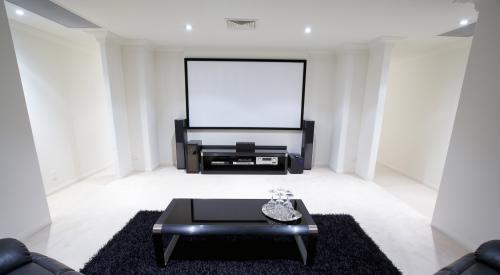|
 |
With open floor plans and higher ceilings it's no wonder that so many home buyers and home builders are saying "Stop the noise!"
The following explains how sound is created within a house and what can be done to control it.
Comparing Wall ConstructionWhen talking about sound, there are two kinds of walls: standard and Class A.
A standard interior wall has 2×4 studs with 16 inch on center spacing and dry wall on both sides. It has no insulation and has not been air sealed.
For Class A walls, you have your choice depending on how much sound control is desired. The figures shown above illustrate show three walls. The first has insulation plus an extra layer of dry wall on one side. The second has insulation with resilient channels added. And the third insulation, a second layer of drywall on one side and resilient channels.
Why is the type of wall construction important? In one word — acoustics.
Acoustics versus SoundAcoustics is the science of sound. Acoustics — as it relates to the home — include how sound is produced and transmitted and the effect it has on the occupants of a home.
Sound is the result of waves of pressure variations in the air vibrating against our eardrums. Sound waves travel through all types of materials — including walls.
Types of SoundThere are two types of sound — airborne and structureborne. Airborne sound is the result of sound waves traveling through air. All sound that reaches your ear is airborne.
Examples of airborne sound include:
- Music
- Traffic sounds
- Voices
- Motors and machinery
Structureborne sound is the result of sound waves traveling along a structural path, such as walls, pipes or beams. Structureborne sound is either felt as a vibration or transmitted as airborne sound.
Examples of structureborne sound include:
- Footsteps
- Door slams
- Plumbing vibrations
- Medical equipment vibrations
- The impact of rain
The relative loudness of a sound is measured by the pressure of its sound waves. Sound is typically measured in decibels.
Our response to changes in sound levels depends on how many decibels the sound increases. For example, most people won't even notice an increase of one or two decibels; however, an increase of three or four decibels is noticeable. An increase of nine to 10 decibels is very pronounced.
Acoustical Performance MeasuresNow that we know a little about the properties of sound, let's look at the ways acoustical products or systems are measured.
There are four ways:
- Sound absorption
- Airborne sound transmission
- Impact sound transmission
- Airborne sound transmission through suspended ceilings
Sound absorption is the ability of a material to absorb sound waves, rather than reflect them. Products that have a lot of air pockets in them — such as fiberglass — are good sound absorbers. Denser material is not as effective at absorbing sound.
There are two specifications that are used in relation to sound absorption:
- NRC (noise reduction coefficient)
- SAA (sound absorption average)
A high NRC means the sound is absorbed more effectively, leaving the space quiet. The SAA is a newer rating method.
The ASTM test method that measures sound absorption is ASTM C423. The ratings, as mentioned above, are the NRC and SAA. The rating is a number between zero and one. For products that absorb better, such as fiberglass, the number will be closer to one. The higher the value, the better the material absorbs sound. For example, an R19 unfaced batt is about .95. This means that 95 percent of the sound energy is absorbed.
Sound TransmissionSound transmission is defined as the decrease in sound energy expressed in decibels of airborne sound as it passes through a structure. Sound transmission is measured by the decrease in sound between two different rooms that are separated, either by a wall or a floor or ceiling system. The rating system for measuring sound transmission is called STC, or the sound transmission class.
The ASTM E-90 is used to test airborne sound transmission. The STC rating is a single number; the higher the number, the better the system is at controlling sound transmission. The general rule of thumb is if you have a 10-point increase in STC, the perceived noise level will drop by about half.
Impact Sound TransmissionImpact sound is the result of vibration of an impact, such as footsteps or an object that is dropped. In a home, this sound is typically heard through the ceiling.
Impact sound transmission is measured in IIC, or Impact Insulation Class. When building a home, it is important to consider floor and ceiling assemblies to minimize impact sound.
The IIC, measured using ASTP E492, is a single number rating that indicates the impact sound insulation performance of floor/ceiling systems.
Airborne Sound Transmission Through CeilingsAirborne sound transmission through ceilings is the result of sound transmitted between rooms with a common air plenum. This is usually an issue when you have acoustical ceilings with partition walls.
Airborne sound transmission through ceilings is measured by CAC, Ceiling Attenuation Class. The CAC, measured using ASTM E1414, is a single number rating that evaluates the efficiency of a suspended ceiling system connected by a common air plenum.
Solutions for a Quieter HomeNow that we've seen how acoustical performance is measured, let's look at practical ways to make a home quieter.
- Room furnishings. When preparing a home to sell, consider adding room furnishings to help with sound control.
- Windows. Windows can also help to control sound. Look for windows that have an STC rating of at least 35–45.
- Doors. Most interior doors have both a hollow core as well as a half-inch gap at the bottom between the door and the floor. A solid core door with a beveled seal will effectively control sound.
- Air sealing. When building the home, remember to seal around window frames and door frames; plumbing and electrical penetrations; and around HVAC penetrations.
- Quiet appliances. A home's equipment, or appliances, can also affect its noise levels. Look for washers, dryers and dishwashers that are described as quiet in the manufacturer's literature.
- Quiet exhaust fans. Exhaust fans — generally found in bathrooms and kitchens — are rated for their quietness. The rating is called a sone rating. A sone is a measure of perceived loudness.
- Fiberglass ducts. Fiberglass ducts can help quiet a home's HVAC system by absorbing mechanical noise.
|












